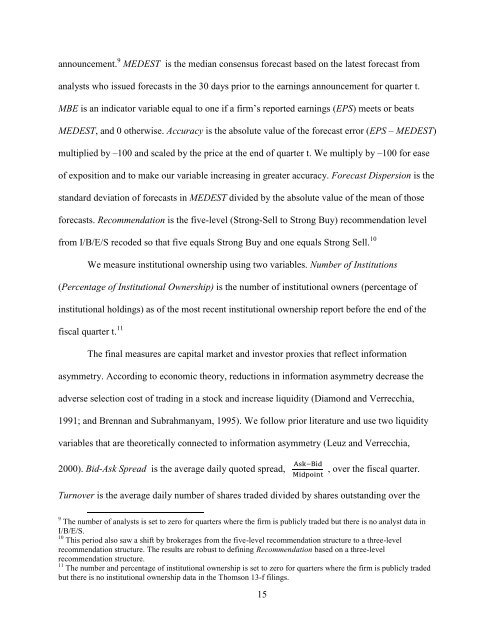Investor Relations and Regulation FD
Investor Relations and Regulation FD
Investor Relations and Regulation FD
You also want an ePaper? Increase the reach of your titles
YUMPU automatically turns print PDFs into web optimized ePapers that Google loves.
announcement. 9 MEDEST is the median consensus forecast based on the latest forecast from<br />
analysts who issued forecasts in the 30 days prior to the earnings announcement for quarter t.<br />
MBE is an indicator variable equal to one if a firm’s reported earnings (EPS) meets or beats<br />
MEDEST, <strong>and</strong> 0 otherwise. Accuracy is the absolute value of the forecast error (EPS – MEDEST)<br />
multiplied by –100 <strong>and</strong> scaled by the price at the end of quarter t. We multiply by –100 for ease<br />
of exposition <strong>and</strong> to make our variable increasing in greater accuracy. Forecast Dispersion is the<br />
st<strong>and</strong>ard deviation of forecasts in MEDEST divided by the absolute value of the mean of those<br />
forecasts. Recommendation is the five-level (Strong-Sell to Strong Buy) recommendation level<br />
from I/B/E/S recoded so that five equals Strong Buy <strong>and</strong> one equals Strong Sell. 10<br />
We measure institutional ownership using two variables. Number of Institutions<br />
(Percentage of Institutional Ownership) is the number of institutional owners (percentage of<br />
institutional holdings) as of the most recent institutional ownership report before the end of the<br />
fiscal quarter t. 11<br />
The final measures are capital market <strong>and</strong> investor proxies that reflect information<br />
asymmetry. According to economic theory, reductions in information asymmetry decrease the<br />
adverse selection cost of trading in a stock <strong>and</strong> increase liquidity (Diamond <strong>and</strong> Verrecchia,<br />
1991; <strong>and</strong> Brennan <strong>and</strong> Subrahmanyam, 1995). We follow prior literature <strong>and</strong> use two liquidity<br />
variables that are theoretically connected to information asymmetry (Leuz <strong>and</strong> Verrecchia,<br />
2000). Bid-Ask Spread is the average daily quoted spread, , over the fiscal quarter.<br />
Turnover is the average daily number of shares traded divided by shares outst<strong>and</strong>ing over the<br />
9<br />
The number of analysts is set to zero for quarters where the firm is publicly traded but there is no analyst data in<br />
I/B/E/S.<br />
10<br />
This period also saw a shift by brokerages from the five-level recommendation structure to a three-level<br />
recommendation structure. The results are robust to defining Recommendation based on a three-level<br />
recommendation structure.<br />
11<br />
The number <strong>and</strong> percentage of institutional ownership is set to zero for quarters where the firm is publicly traded<br />
but there is no institutional ownership data in the Thomson 13-f filings.<br />
15
















